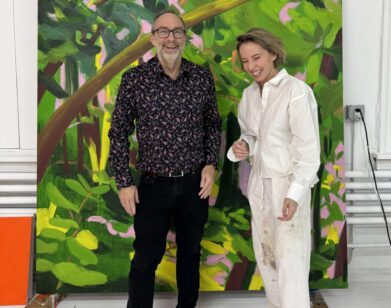Todd Kreher
“Seeing a fenced space, one thinks of Foucault’s work on the penitentiary. What strikes me about Todd Kreher’s drawings is how his fence considers inside and outside, looking and being looked at. The moiré occurs when the viewer is caught looking through spaces where the fence overlaps are no longer fences but color fields, a nonpoliced space to move and think.” —Kelley Walker
Todd Kreher’s rigid, zigzagging grids, drawn in ink on a white-paper background, at first seem to have a touch of M.C. Escher’s surrealist architecture underscored with formal abstract minimalism. But the grids are not by definition abstract (nor are they designed with impossible perspectives, as in Escher’s images). Rather, they come into focus as a surprisingly mundane object: a chain-link fence. “I was painting my backyard, which had a fence,” Kreher says, recalling an undergraduate class at the Art Institute of Chicago. “It was the most resolved part of the paintings. My teachers nudged me to explore that.” Kreher went on to obtain his MFA at Yale in 2007, and shortly after moving to New York, began assisting at Kelley Walker’s studio. In recent years, the 34-year-old has revisited the chain-link fence as his central motif, and a series of about 20 untitled works is the result.
Partly guiding the drawings is a concept called spatial empathy, a term Kreher picked up from an architecture class. “In this context, the eye can touch the edges, feel how certain spaces jut out or become closer together,” he explains. Viewed in person, the crisscrossing lines take on an optical effect called a moiré, when “two regular grids overlap at slight angles, and you get a third visual element,” he says. What’s especially impressive about the visual effect, achieved only with precise slants, is that Kreher traced the minute mesh of the fence freehanded. “I like the slight imperfections in there,” he says. “[Finishing one] takes me two weeks if I’m on schedule.”







